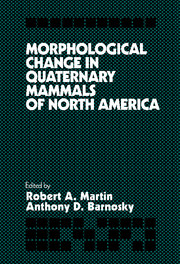Book contents
- Frontmatter
- Contents
- List of Contributors
- Acknowledgments
- 1 Quaternary mammals and evolutionary theory: introductory remarks and historical perspective
- 2 A method for recognizing morphological stasis
- 3 Mosaic evolution at the population level in Microtus pennsylvanicus
- 4 Variogram analysis of paleontological data
- 5 Morphological change in Quaternary mammals: a role for species interactions?
- 6 Rates of evolution in Plio-Pleistocene mammals: six case studies
- 7 Patterns of dental variation and evolution in prairie dogs, genus Cynomys
- 8 Quantitative and qualitative evolution in the giant armadillo Holmesina (Edentata: Pampatheriidae) in Florida
- 9 Evolution of mammoths and moose: the Holarctic perspective
- 10 Evolution of hypsodonty and enamel structure in Plio-Pleistocene rodents
- 11 Patterns of variation and speciation in Quaternary rodents
- 12 Decrease in body size of white-tailed deer (Odocoileus virginianus) during the late Holocene in South Carolina and Georgia
- 13 Short–term fluctuations in small mammals of the late Pleistocene from eastern Washington
- 14 Size change in North American Quaternary jaguars
- 15 Ontogenetic change of Ondatra zibethicus (Arvicolidae, Rodentia) cheek teeth analyzed by digital image processing
- 16 Morphological change in woodrat (Rodentia: Cricetidae) molars
- Index
6 - Rates of evolution in Plio-Pleistocene mammals: six case studies
Published online by Cambridge University Press: 15 December 2009
- Frontmatter
- Contents
- List of Contributors
- Acknowledgments
- 1 Quaternary mammals and evolutionary theory: introductory remarks and historical perspective
- 2 A method for recognizing morphological stasis
- 3 Mosaic evolution at the population level in Microtus pennsylvanicus
- 4 Variogram analysis of paleontological data
- 5 Morphological change in Quaternary mammals: a role for species interactions?
- 6 Rates of evolution in Plio-Pleistocene mammals: six case studies
- 7 Patterns of dental variation and evolution in prairie dogs, genus Cynomys
- 8 Quantitative and qualitative evolution in the giant armadillo Holmesina (Edentata: Pampatheriidae) in Florida
- 9 Evolution of mammoths and moose: the Holarctic perspective
- 10 Evolution of hypsodonty and enamel structure in Plio-Pleistocene rodents
- 11 Patterns of variation and speciation in Quaternary rodents
- 12 Decrease in body size of white-tailed deer (Odocoileus virginianus) during the late Holocene in South Carolina and Georgia
- 13 Short–term fluctuations in small mammals of the late Pleistocene from eastern Washington
- 14 Size change in North American Quaternary jaguars
- 15 Ontogenetic change of Ondatra zibethicus (Arvicolidae, Rodentia) cheek teeth analyzed by digital image processing
- 16 Morphological change in woodrat (Rodentia: Cricetidae) molars
- Index
Summary
Evolution, in general, means change over time: The end is different from the beginning. Change is not inevitable, but it seems to be common. And some change can almost always be observed, given enough time. When do we see change? How much time does it take? To study evolution we have to measure change and time, and to understand evolution we have to know how the two are related.
Evolution in biology is often described as a process, but it is really a collection of processes – including the processes of mutation, dispersion, drift, and selection – that together produce whatever change we see. These processes may each be complicated individually, and their interactions produce additional complexity. Evolution is widely acknowledged as a fundamental concept in biology, and yet we have a surprisingly anecdotal and casual knowledge of how evolutionary change takes place. One way to improve this understanding is to quantify change over time in terms of rate. Evolutionary rates are quantitative expressions relating change to time.
Evolution takes place on many scales of time. Field and laboratory experiments can be designed to study change on short time scales, and fossils provide the most direct and best information about evolution on long time scales. The principal problem with the fossil record is that the time scales involved, typically millions of years, are so long that they are difficult to relate to the time scales of our lifetimes (and those of other organisms). Biologists as a group have a surprisingly poor understanding of evolution on a geological scale of time, and paleontologists as a group have a surprisingly poor understanding of evolution on a biological scale of time.
- Type
- Chapter
- Information
- Morphological Change in Quaternary Mammals of North America , pp. 84 - 106Publisher: Cambridge University PressPrint publication year: 1993
- 4
- Cited by

